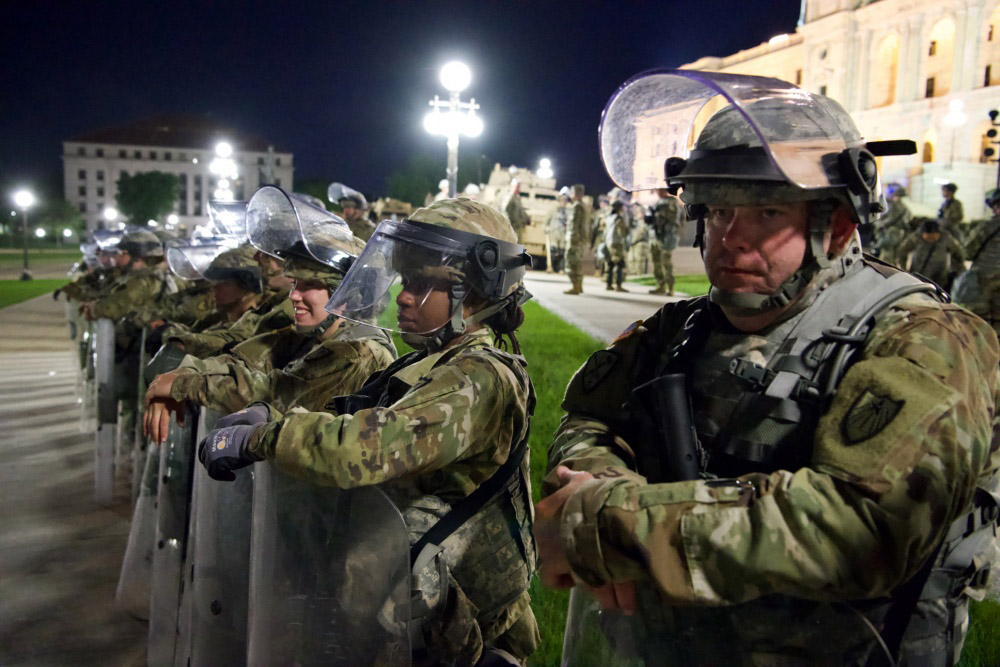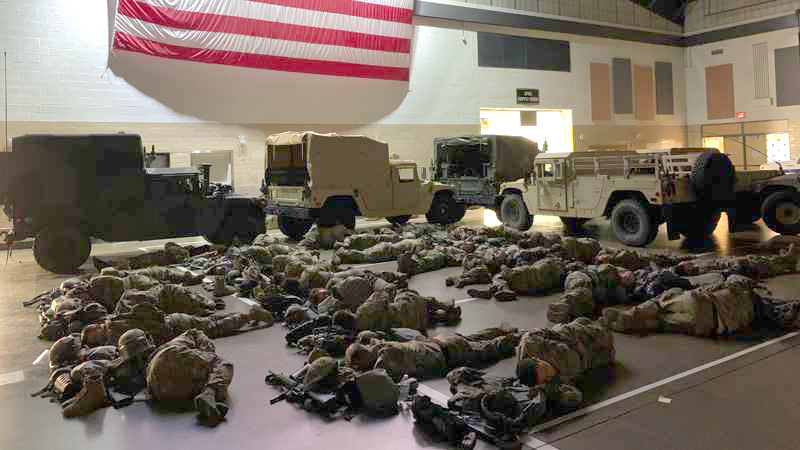 ,
, 
When protests turned violent in Minneapolis and St. Paul on May 27, troopers from around the state were dispatched with the Minnesota State Patrol to support Twin Cities law enforcement.
In the days following George Floyd’s May 25 death under the knee of a Minneapolis police officer, dozens of southwest Minnesota personnel in uniform were called to help.
Austin Christensen, Luverne, was among six troopers from Rock County to respond.
He was five minutes away from signing off from a 10-hour shift when the all-call went out to Minnesota troopers to head to the Cities.
“We’re trained in riot control and equipped for the mobile response team,” he said. “But being down here in Luverne, I figured I’d never have to use the training and the equipment.”
So, at 2 a.m. he packed his bags and riot gear, drove four hours, parked his squad in a suburban lot among hundreds of others and boarded a bus with dozens of other Troopers. “You are here because Minneapolis lost the city,” they were told.
The bus dropped them off on Lake Street near the Minneapolis police precinct that had been destroyed in riots.
“It was surreal,” Christensen said. In the early-morning daylight, he said smoke and dust rose from the rubble of what had once been a South Minneapolis neighborhood.
“I was surprised how bad it had gotten. The air quality was so bad it was hard to breathe.”
They relieved a line of law enforcement personnel who had worked through the night to establish security for firefighters and public works crews.
Christensen spent the next 14 hours shoulder-to-shoulder with law enforcement personnel he’d never met to control crowds of demonstrators, many who were angry at law enforcement.
“There was a lot of name-calling and cursing,” he said. “But there were a lot of silent supporters, probably residents in the community, who would walk in front of us with small signs that only we could read. They’d say, ‘Thank you,’ or ‘We’re glad you’re here.’”
At 8 p.m. after 28 hours on the job, he finally got to lie down before his next shift started at 3 a.m. He was exhausted, but he wasn’t alone. Nearly every outstate officer reported a similar experience, especially during the first few chaotic days.
‘… like a war zone’
Lt. Matt Sorenson, rural Rock County, led a group of 30 troopers during his eight-day stint in the Cities.
“Our role was to stop the rioting and looting and protect people and property,” Sorenson said. He spent two days jockeying schedules to assign troopers from his Marshall district to help, only to end up with everyone going.
“At first we showed up and went wherever we were needed,” Sorenson said about providing security for firefighters at burning buildings and helping on “the line” of law enforcement working to keep demonstrations peaceful.
“At times it was like a war zone,” he said, describing cars and buildings torched and destroyed, and angry protestors screaming obscenities in officers’ faces. “There was a lot of devastation.”
Graffiti and posters proclaimed law enforcement as the enemy, and Sorenson found himself standing on a corner under an oversized hand-written sign, “The only good cops are dead cops.”
At the end of what often became 24-hour shifts, many at first found themselves in improvised lodging arrangements, on floors and cots in makeshift staging areas.
They eventually found lodging and delivered meals (often cold by the time their shifts ended), but this was complicated by pandemic closures that reduced staffing and services for hospitality businesses.
But even during the early days of mayhem, Sorenson said there were sincere individuals among the bad actors.
Glimmers of positivity
“We had people offering us water and sandwiches and saying, ‘Thank you for being here to protect us,” Sorenson said.
“You go there expecting all bad people, because that’s what you’re getting sent to help with, but you get there and realize there are a lot of good people in the crowd.”
The key was to recognize the good among the bad.
“You try to talk to people and tell them we’re not against peaceful protest; we’re there to keep them safe,” Sorenson said.
When it was time to enforce curfew, there were several announcements over loudspeakers that crowds would need to follow the lawful order to disperse or be arrested.
“At the end of the day, they’d notice we were putting on our gas masks, and they’d realize there might be tear gas if they didn’t disperse,” he said.
“The peaceful people knew what was going to happen and they’d leave. Those who didn’t, you could generally figure weren’t going to be peaceful.”
Historic deployment of Minnesota National Guard
As additional manpower arrived in the Twin Cities, Sorenson said law enforcement leaders were better equipped to coordinate resources among the agencies.
They included police, patrol, sheriff’s offices, DNR and on May 30 the Minnesota National Guard deployed 5,000 citizen soldiers.
It was the largest deployment in the history of the organization.
Jonathan Stearns is a specialist with the Luverne unit of the Army National Guard that was deployed May 30 to provide security in the Twin Cities. He spent 14-hour shifts guarding the state Capitol building and the medical examiner’s building.
In those locations at that time, demonstrations were more organized and peaceful than those on Lake Street earlier in the week.
He said guardsmen routinely shared conversations with demonstrators.
“People I encountered were pleasant and talkative, and it was an opportunity to spread a positive image and be here for the people of Minnesota,” Stearns said.
“I think most people support law enforcement and care for law enforcement. The ones who don’t are the ones getting their message out.”
Stearns, a 2018 Luverne High School graduate, recently earned his law enforcement degree at Alexandria Technical and Community College and is seeking a job in law enforcement.
He said he’s not deterred by the current national backlash against law enforcement.
“Do as you’re trained, talk to all people as if they’re normal people like us, and try not to be too authoritative,” Stearns said.
“Alex Tech is a top school for law enforcement. I’m trusting the training they gave me and happy to put it to good use.”
De-mobilizing includes coronavirus testing
De-mobilizing the troops has proven to be challenging as well, considering potential coronavirus exposure. They were provided options for testing, and as positive cases are reported, two-week quarantines are put in place, further complicating schedules for returning personnel.
“They all have a schedule but they got abruptly disrupted for seven to nine days,” Sorenson said. “People came back different days, and the problem is getting coverage without too much overtime.”
He said he was grateful for support of rural sheriff’s offices and police departments while the State Patrol was in the Cities. “They were more than willing to help us out, and presumably grateful they didn’t have to have guys up there.”
As of Tuesday, he was still working on getting his Marshall District back to normal.
“We want to get back to our main focus as quickly as possible, which is traffic safety.”


